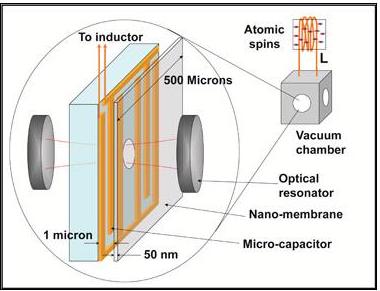Researchers from the Denmark-based Neils Bohr Institute, the Joint Quantum Institute and Harvard University, have formulated a theory that explains the method of sensing weak electrical signals as well as cool electrical circuits with the help of light, which is similar to a nanosized loudspeaker.
 Schematic of device to help detect electrical signals
Schematic of device to help detect electrical signals
In case the research is proved by experimentation, it will have a significant effect on sensing low-intensity radio signals, the quantum information science field and MRI.
The JQI is a collaboration between the College Park-based University of Maryland and the National Institute of Standards and Technology (NIST). According to Jake Taylor, JQI physicist, the experiment aims to integrate an electrical circuit and a nanomechanical membrane, thus enabling even a very weak electrical signal to cause slight vibration of the membrane as a function of the signal intensity. Photons from a laser can be bounced off the membrane and the signal can be read by determining the reflected light modulation as it undergoes a shift due to the movement of the membrane.
Current technology used for light wavelength measurement has a very high sensitivity that makes it perfect for sensing the loudspeaker’s nanoscopic motions that is caused by very feeble electrical signals.
MRI procedures can be done with more ease if it is possible to sense very feeble electrical signals.
According to Taylor, MRI machines are of a considerable size since they have high-power superconducting magnets but if it is possible to reduce the signal strength required to take a reading, the size and strength of the magnets can be minimized. He said that it may be possible to get an MRI without any huge machines and without the tube.
In order to transmit photons that hold energy from one qubit to another, it is possible to use the same setup. A familiar quantum information system design utilizes light for transmission of information among qubits, which are tangled particles that will use the strange properties of quantum phenomena to do calculations not possible for present-day computers. It is possible to use the nanospeaker to obtain optical photons by translation of signals of low-energy from a quantum processor.
Cooling of the system will also be incorporated. As per calculations, converting the loudspeaker’s mechanical motion into photons will cause a significant amount of heat that will minimize system noise and offer improved signal detection.